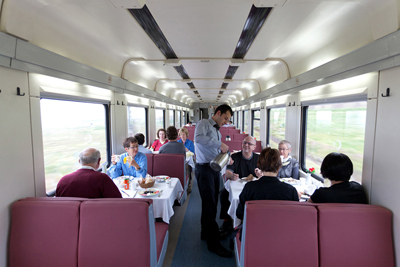Speeding through Europe on a bullet train
European train travel is easier and better than ever, thanks to faster trains, new routes, and additional amenities to keep you comfortable and entertained on the journey. For me, there's nothing better than stretching out in a quiet car, blitzing through the European countryside, with hours of uninterrupted time to think and write.
Recently I spent seven hours on one of Europe's luxurious bullet trains. At 12:14 p.m., I settled into my seat, and at 12:16 p.m., the train was gliding out of the station. In no time, I was rocketing toward my next destination, writing and enjoying every moment. The speedometer in my train car was a little shy -- only being illuminated when it exceeded 300 kilometers per hour (that's nearly 200 miles per hour). The ride was smooth and silent, with pristine pastoral countryside beyond the tinted windows and then, zip, we were pulling into the station.
Europe's new bullet trains are sleek. In fact, they're so sleek that when a city has an old-fashioned, dead-end train station, fast trains often don't even bother to stop in the city itself, but at a pass-through suburban station instead. New stations are designed -- at the insistence of the train companies -- to be pass-through stations. Everything's going very fast these days, and there's just no time to pull in, then back out.
I was recently in the Munich train station taking pictures of trains pulling into the station; more specifically I was taking a photo of what was once a cute little bird that had smashed to the front window of the train. When I saw that little bird I thought two things: First, this is a dangerous continent if you happen to be a slow bird. Second, this is a surreal image. You'd wait all your life to see a bird squished to the window of a train where I live. I could imagine one sitting on the roof in a folding chair smoking a cigar and sipping a drink perhaps ... but not squished to the window.
If you're not a bird, bullet trains allow you to maximize sightseeing, making once time-consuming trips a breeze. For instance, you can get from Munich to Nuremberg in just one hour or from Frankfurt toCologne in less than 90 minutes, making it easy to day trip to these cities. The journey between Barcelona and Madrid takes less than three hours -- comparable to the amount of time it would take to trek to the airport, wait an hour, and fly.
While France's high-speed rail once linked mostly just French cities, recently it has started to provide direct service into neighboring countries, zipping travelers from Paris to Milan in seven hours andMunich or Barcelona in six. Travelers don't need to change trains at the border, and travel times will continue to drop as sections of track get updated each year.
Fast trains aren't necessarily cheap, but you can often find good deals if you plan ahead. As with plane tickets, train prices can vary depending on demand, restrictions, and how early you purchase. For instance, nonrefundable or nonrebookable tickets can be cheaper, and purchasing tickets in advance can save you money. Tickets are usually available about three months in advance, and the earlier you buy, the better, as the cheapest rates sell out quickly. To find the best deals, visit that country's rail website.
You'll also find more options (and sometimes better deals) on train tickets in countries where there are multiple rail operators. While national railway companies once controlled each country's train service, in some places they now share the high-speed market. For instance, the Austrian Federal Railway, which operates the fast RailJet service, now has competition from the privately owned WESTbahn.
I used to love taking night trains, as they let you skip the cost of a hotel and gain a day of sightseeing. But as daytime trains have gotten faster and flights have become more affordable, overnight trains have dwindled. For example, you can no longer sleep your way from Amsterdam to Prague or from Barcelona to Madrid. For now, a service called Thello is continuing the tradition of Paris toVenice night trains (travel time: 13 and a half hours), but unless you really enjoy the romance of having dinner in Paris and waking up to breakfast in Venice, a budget flight is both faster and cheaper.
Despite the convenience of flying, I still opt for trains whenever possible. To me, they're a quintessential European experience and a more environmentally friendly way to travel. In fact, today's trains are so quiet and efficient that I almost miss the old clackity-clackity rhythm of the rails. It's been replaced by a nearly silent swoosh, as futuristic trains cut like bullets through the green and tidy countryside.
(Rick Steves (www.ricksteves.com) writes European travel guidebooks and hosts travel shows on public television and public radio. Email him c/o ITN and follow his blog onFacebook.)


